

Communication Plan. How Do You Use the Force Field Analysis in Business? The force field analysis is a model that can be used in business to evaluate the feasibility of proposed organizational change projects.
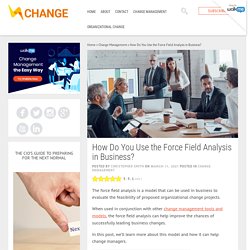
When used in conjunction with other change management tools and models, the force field analysis can help improve the chances of successfully leading business changes. In this post, we’ll learn more about this model and how it can help change managers. What is the force field analysis of change? In a nutshell, the force field analysis is a framework for understanding the factors that influence a potential change. In the context of business, the changes looked at are usually organizational changes. The model, developed by social psychologist Kurt Lewin, describes situations as an equilibirum between two types of forces – forces that are either driving movement toward a goal (helping forces) or blocking movement toward a goal (hindering forces). How to Create a Force Field Analysis Template in 60 Seconds. Creating a force field analysis template can be done in seconds and it can be applied with minimal effort.
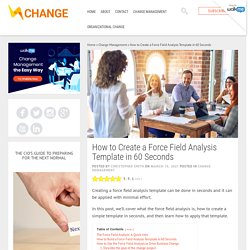
In this post, we’ll cover what the force field analysis is, how to create a simple template in seconds, and then learn how to apply that template. The Force Field Analysis: A Quick Intro The force field analysis is a model that change managers can use to assess proposed business change projects. Originally developed as a social psychology model by Kurt Lewin, business professionals now use it to analyze the forces that are supporting and opposing potential changes. 50+ Must-Know Change Management Questions. One of the best ways to ensure that an organizational change project operates smoothly is by asking and answering the right change management questions.
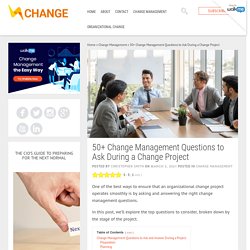
In this post, we’ll explore the top questions to consider, broken down by the stage of the project. There are several ways to segment a project’s life cycle, or the stages that a project progresses through. Below, we’ll break the project roadmap into four stages: Preparation. Tool: Yesterday-Tomorrow Exercise Fillable Worksheet. Intégrer l'étude d'impacts dans votre stratégie de conduite du changement. Étude d’impacts ?
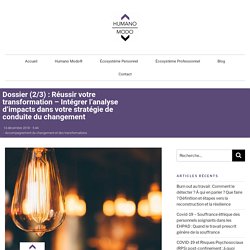
… (Silence). C’est la réponse que j’obtiens 8 fois sur 10 quand j’évoque ce dispositif de conduite du changement à des interlocuteurs, plus ou moins impliqués dans l’accompagnement des transformations. L’étude d’impacts (ou analyse d’impacts) n’est pas une pratique généralisée dans les organisations malgré son rôle essentiel dans l’accompagnement des parties prenantes. Cet article a pour objectif de vous présenter ce qu’est l’étude d’impacts, les enjeux associés et les gains possibles en matière d’accompagnement au changement et plus largement dans la réussite d’un projet de transformation. Par ailleurs, face aux besoins des entreprises sur le sujet, j’ai créé une méthode permettant aux organisations de s’approprier et déployer le dispositif : Capt’Impacts©, pour une transformation plus humaine et performante. Prosci ADKAR "I" Statements and Force Field Analysis. What to Include in a Change Management Policy Template.
A change management policy template can serve as the basis for one’s own change management policy.
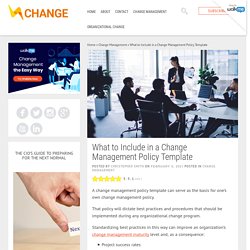
That policy will dictate best practices and procedures that should be implemented during any organizational change program. Standardizing best practices in this way can improve an organization’s change management maturity level and, as a consequence: Project success ratesProject outcomesEmployee productivity, performance, and engagementThe profitability of projects In short, change management policies can raise competency and performance across the organization. Why Clarity Is Crucial For Every Change Project. When there’s no WIIFM: 5 tips to create support during difficult change. Running projects with no clear benefits to the individual can be a nightmare scenario for change managers.

Here’s how to make bitter change more palatable. “This is the stupidest idea I’ve ever heard.” We had just announced a critical shift in the way our projects are catalogued. For years the business had been applying a numbering system that included year, cost center, project type and other critical information. Begin With the End in Mind. Why do we do change management?

To build excellent plans? To abide by best practices in business? To appease our leadership team that decided we needed it? LinkedIn by Annapurna A. How to Set (and Reach) Goals in Wildly Unpredictable Times. The third week of January, surveys tell us, is when most New Year's resolutions die, and I'm betting the killing fields are particularly bloody this year.
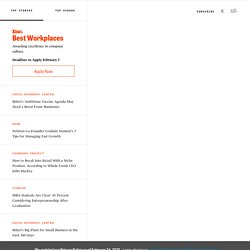
America may have a new president and the world a handful of effective vaccines, but while hope is on the horizon, it's a safe bet that 2021 will still be wild. Unpredictability makes resolutions even harder to keep. Given that none of us know what the next months will throw at us, should you even try to set goals for yourself and your business? Business paradigms - the key to change, strategy and innovation. Paradigms are the assumptions, models or beliefs we hold, that affect how we understand ourselves and what is happening in the world around us.
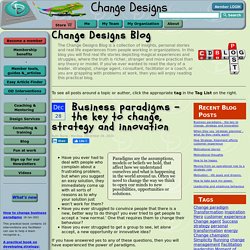
Often we need to change the way we think to open our minds to new possibilities, opportunities or solutions. Have you ever had to deal with people who complain about a frustrating problem, but when you suggest an easy solution, they immediately come up with all sorts of reasons as to why your solution just won’t work for them? Have you ever struggled to convince people that there is a new, better way to do things?
Tool: A project team charter template. Strategies for resourcing your change. Envision a Better Future: Organizational Change. Wharton@Work Greg Shea describes the current business environment as having been “redesigned on the fly.”
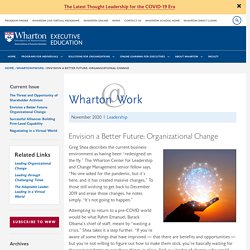
The Wharton Center for Leadership and Change Management senior fellow says, “No one asked for the pandemic, but it’s here, and it has created massive changes.” To those still wishing to get back to December 2019 and erase those changes, he notes simply, “It’s not going to happen.” Attempting to return to a pre-COVID world would be what Rahm Emanuel, Barack Obama’s chief of staff, meant by “wasting a crisis.”
Shea takes it a step further. Making them stick, he says, takes a “deliberate, evaluative process. Shea has been teaching such a process as director of the Leading Organizational Change program for over a decade. The Model at Work: It’s Not Just About the Pandemic A few years ago, Shea was approached by the head of diversity and inclusion in a large organization. Shea divided the group into teams and asked them to envision in detail “desired stories from the future.” Person. The Change Management Battle Plan.
Change Management Review. When was the last time that a change you were supporting produced results that no one wanted? Unacceptable drops in productivity; unprecedented loss of customers; quality declines…none of these is what we want as outcomes. All of them are too often the unintended outcomes. Years ago, during the deregulation of the telecom industry a prospective client said this about the result of their new strategy. Planning for Resistance Management. When defining a change approach. Planning, managing and delivering change in a post-Covid-19 world (On demand webinar) Infographic - Project change planning for post-Covid. When Planning & Uncertainty Collide. Mark Mullaly - May 6, 2020 Mark Mullaly is president of Interthink Consulting Incorporated, an organizational development and change firm specializing in the creation of effective organizational project management solutions.
Since 1990, it has worked with companies throughout North America to develop, enhance and implement effective project management tools, processes, structures and capabilities. Mark was most recently co-lead investigator of the Value of Project Management research project sponsored by PMI. You can read more of his writing at markmullaly.com. As project managers, we like planning. Regardless of where you personally live on this spectrum, there is a plan. One of Eisenhower's more famous quotes was, "In preparing for battle I have always found that plans are useless, but planning is indispensable. " Podcast - Change Scenarios – What Will the New Normal Look Like Post-Corona Crisis? – With Melanie Franklin. Podcast: Play in new window | Download Subscribe: Apple Podcasts | Android | In this episode of the Change Management Review™ Podcast, Theresa Moulton interviews Melanie Franklin, Co-Chair of the Change Management Institute UK, Director of Agile Change Management LTD, and a respected author of text books and articles on change, project, and program management.
Melanie is also an examiner, responsible for assurance of the work of a team of examiners creating professional qualifications in Change Management. Melanie is highly respected in her field and is sought-out by many organizations all over the world who need support in creating their strategy and plans for managing change. In this session, Melanie will share some of the thinking she is developing on behalf of a number of organizations who are using these scenarios to update their strategic plans. Guide for change re-planning - infographic. Craft a Compelling 'Why' to Inspire Action - On demand webinar. COVID-19: How business leaders should plan ahead - Podcast. In this episode of Inside the Strategy Room, we share an excerpt from a webcast on how companies can change their operations to navigate the vast business challenges heading their way.
It was recorded at the 2020 Global Business Leaders Forum, scheduled to take place in New York in early April but instead held virtually. In this session, Martin Hirt, a senior partner and a global co-leader of McKinsey’s Strategy and Corporate Finance practice, offers his insights based the recent articles he co-authored, “Safeguarding our lives and our livelihoods” and “Getting ahead of the next stage of the coronavirus crisis.” This is an edited transcript. For more conversations on the strategy issues that matter, subscribe to the series on Apple Podcasts or Google Play. Audio.
Change Management: The Essentials: The modern playbook for new and experienced practitioners (2020) by Lena Ross. COVID-19 Planning Scenarios for Business Leaders. On designing good change programs. A guide to change planning during coronavirus – The role for change practitioners. “When disaster strikes, it tears the curtain away from the festering problems that we have beneath them,” Obama Most of the world is now shrouded in a thick cloud that is the coronavirus. It is shaping a lot of our daily lives, from shopping, travelling, visiting friends, work, economy and not the least health.
Some businesses are going under whilst others struck with sudden increased demand. Chaos and panic abound. There will certainly be significant levels of economic and therefore industry impacts resulting from the virus. Let’s outline some of the current landscape and what a lot of businesses are undergoing. TOP 40+ QUESTIONS TO ASK BEFORE EMBARKING ON ANY CHANGE. Organizational change management checklist Change management: why, how, what, when, who Companies increasingly face competitive pressures related to rapid and continuous adaptation to a complex, dynamic and highly interconnected global environment.
When embarking on a change journey – what questions to ask Dealing with or managing any type of change is now a common occurrence in most organizations. In recent years, technological growth, the information age, changes in habits, changes in global economy and the business environment have forced organizations to change the way they do business. Interview: Defining A Project's True Finish Line. Change Management: 6 Simple Steps to Get Started. Stephanie Jaeger PMI Kenya Chapter - December 11, 2019. Goal Setting: A Scientific Guide to Setting and Achieving Goals. Change from the Future: The Merlin Process and Strategy Mapping, with Amie Devero (Podcast) 6 Essential Change Management Plan Templates. How to Approach Change and Learning Using Action Research (Podcast)
Begin with the End in Mind. Leading large scale change: A practical guide (2018) Why change legacy and change impact are essential factors in a data driven change management approach. "The earlier change practitioners get involved in projects, the more successful the outcome of the project - Towers Watson study found. Use this agile technique little known in change management to get the best outcomes. The MoSCoW technique of prioritising initiative requirements or features The MoSCoW method of prioritization is well used by Business Analysts, Project Managers and Software Developers. The focus is on identifying and agreeing with key stakeholders what are the core levels of requirements that should be focused on more than others.
This process of prioritization will then enable a better outcome in focusing the efforts of the team on the most important aspects of the solution given limited time and cost. Four Ways Cultural Awareness Impacts Change Management (On demand short webinar) Charting Change: A Visual Toolkit for Making Change Stick (2016) by Braden Kelley.
Planning in an agile organization. Companies large and small are discovering that agility—the ability to quickly reorient the organization toward valuable opportunities—can improve the performance of working groups across the enterprise. Agile ways of working can also reduce risk and create flexibility, because they allow teams to test and validate ideas before the business commits to developing them. These benefits can be lessened, however, if companies don’t apply agile concepts to enterprise-wide processes—particularly the planning and budgeting processes, by which companies translate their strategy into decisions about how to allocate people and resources.
When agile teams must submit ideas to a planning committee and wait months for funding, they can miss out on precious opportunities to win customers or boost efficiency. Why Defining the Scope of Change Management is Critical. How to Define a Change Management Strategy. Designing quality change experiences. Before You Act, Consider These Keys to Preparing for Change. Effectively Adding Motivation to Your Change Management Strategy. Getting Organizational Change Management Right the First Time. Visioning for Success: Part 1.
Job Crafting as Reaction to Organizational Change. Charting Change, With Braden Kelley. Top 40+ questions to ask before embarking on any change.